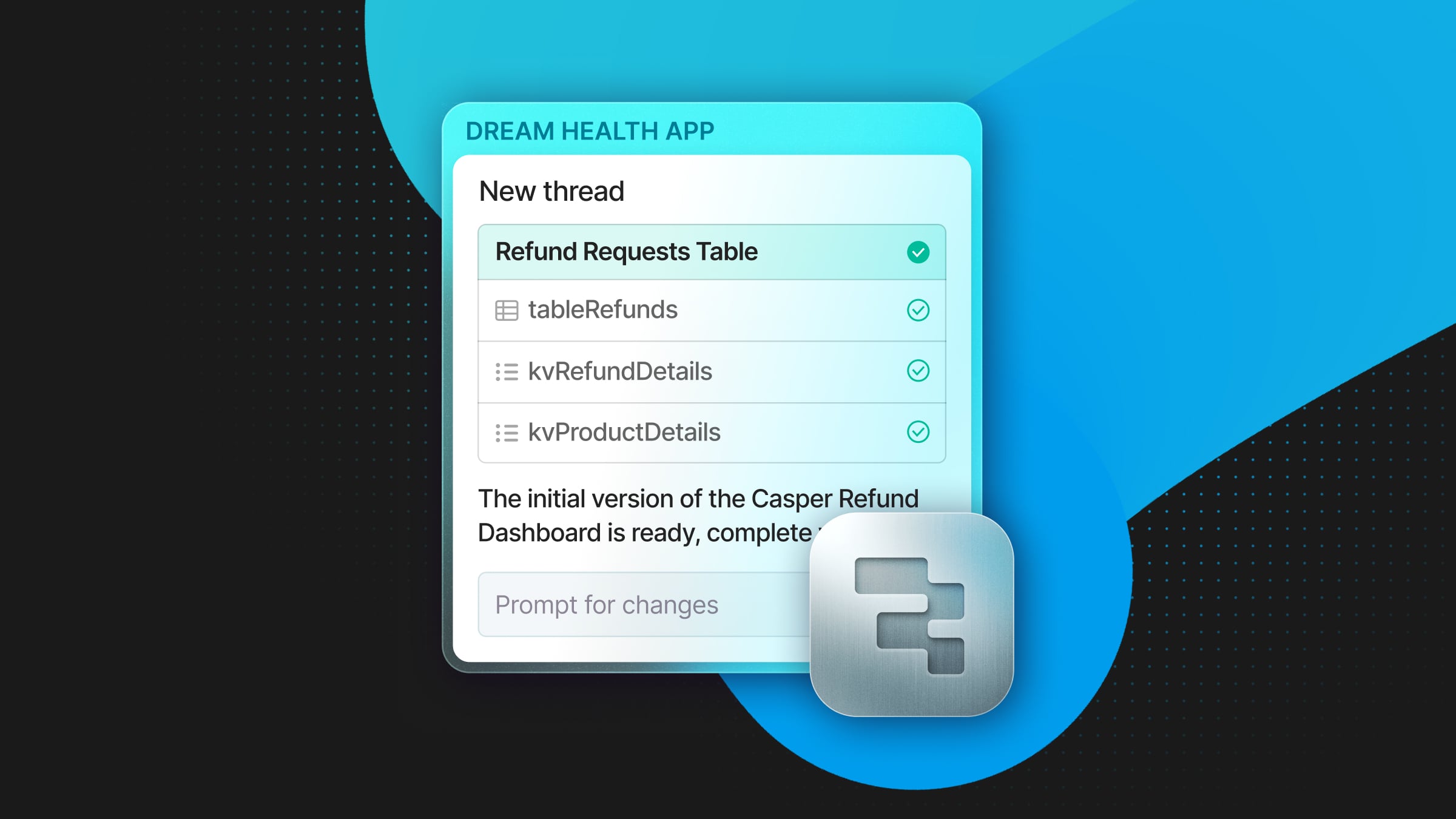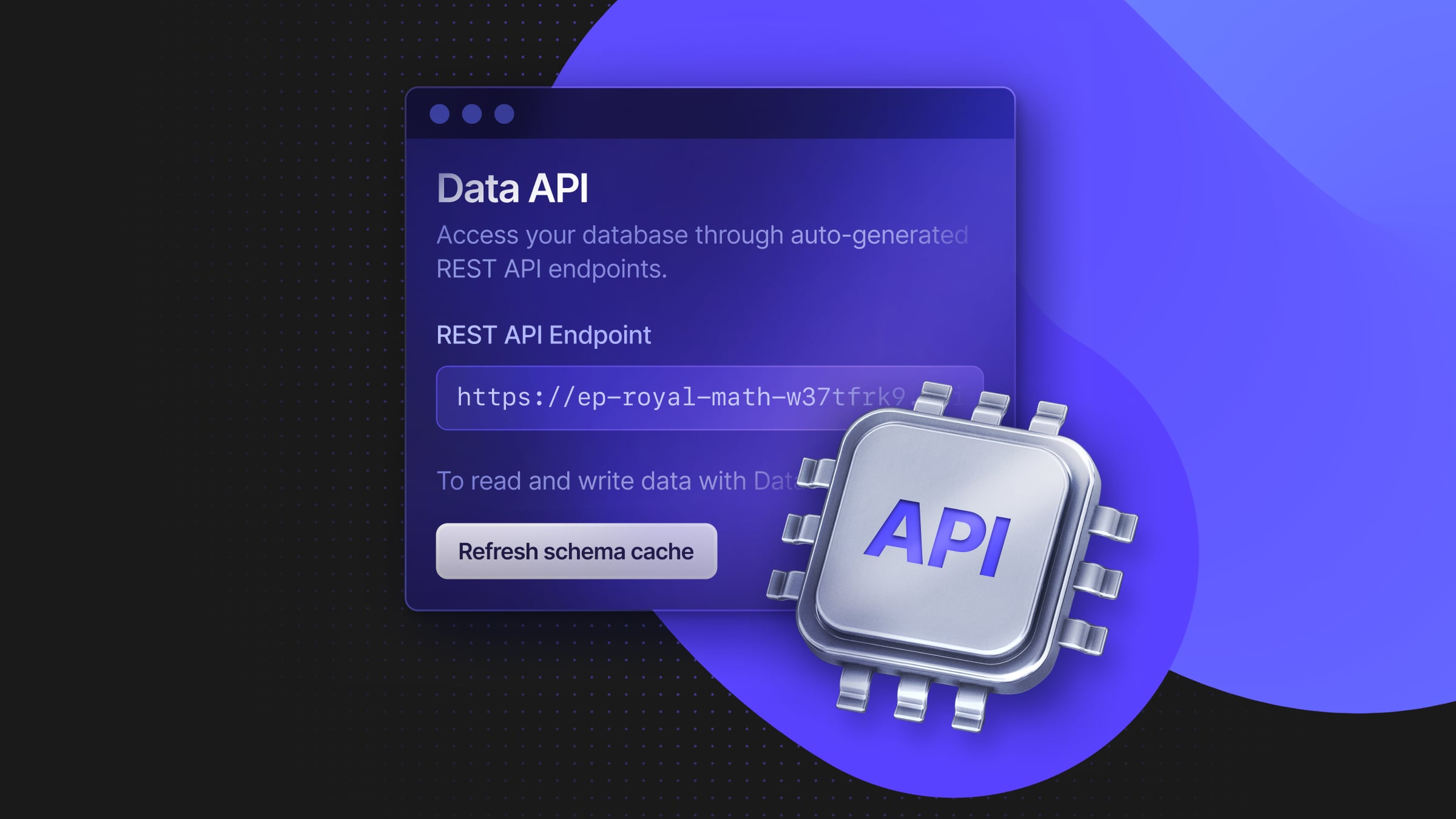Authenticating users in Astro using Neon Postgres and Lucia Auth
Step-by-step guide to building user authentication in Astro application with Lucia Auth and Postgres powered by Neon
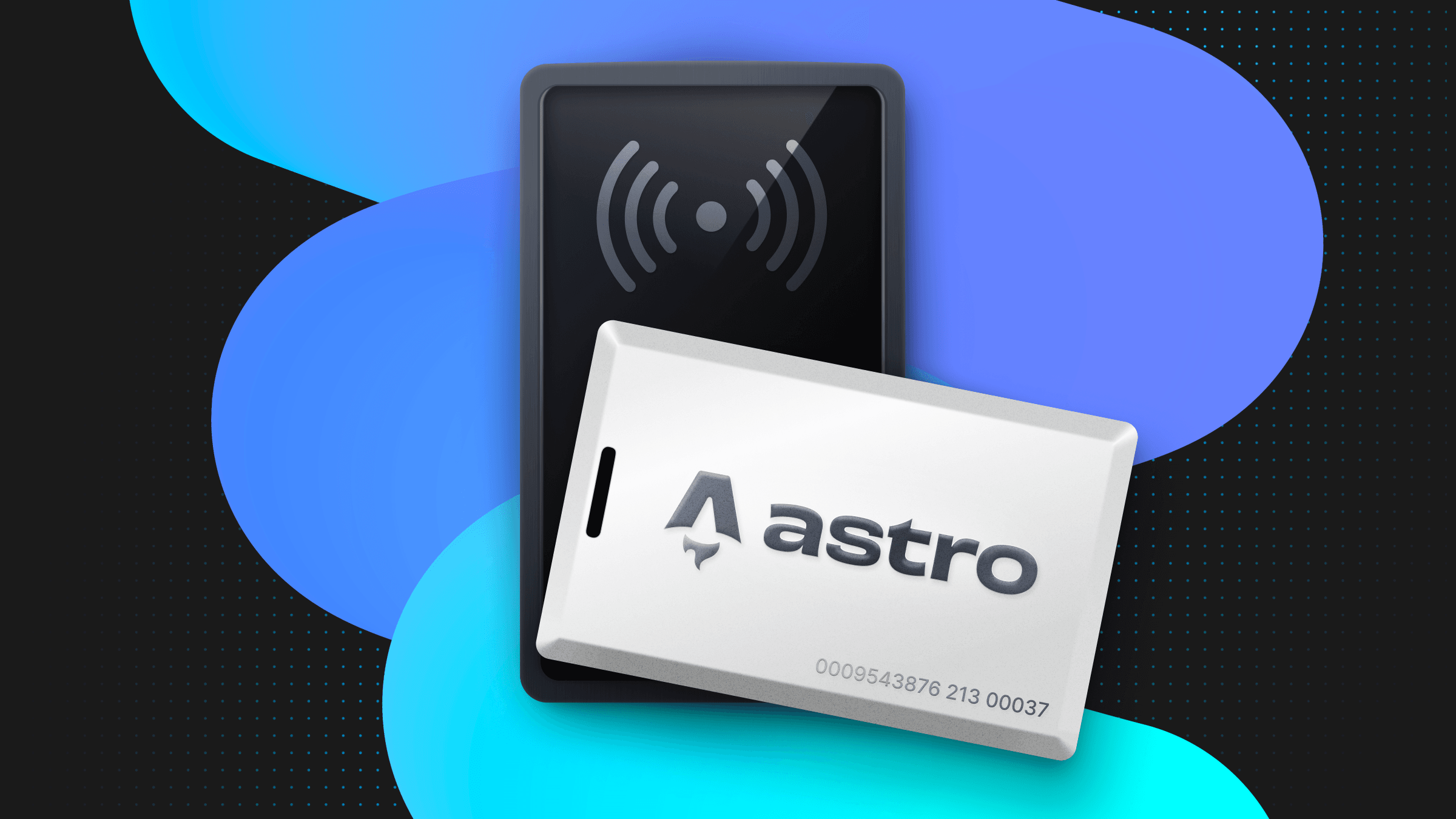
This guide covers the step-by-step process of building user authentication APIs and HTML pages in Astro application with Lucia Auth and Postgres, powered by Neon. User authentication provides a way to manage user identities and access control in your application. Upon completing the guide, you would have an understanding of how to perform user authentication using Lucia Auth and protect a page from unauthorized access.
Prerequisites
To follow along this guide, you will need the following:
- Node.js 18 or later
- A Neon account
- A Vercel account
Steps
- Provisioning a Serverless Postgres powered by Neon
- Create a new Astro application
- Add Tailwind CSS to the application
- Enabling Server Side Rendering in Astro with Vercel
- Setting up a Postgres Database Connection and Schema
- Setup Lucia Auth with Neon Postgres
- Define the Astro application routes
- Build the User Authentication Routes
- Deploy To Vercel
Provisioning a Serverless Postgres powered by Neon
Using Serverless Postgres database powered by Neon helps you scale down to zero. With Neon, you only have to pay for what you use.
To get started, go to the Neon console and enter the name of your choice as the project name. You can pick a region near where you will deploy your Astro application. By default, version 16 of Postgres is used. Finally, click on Create Project to create the Postgres database named neondb (by default).
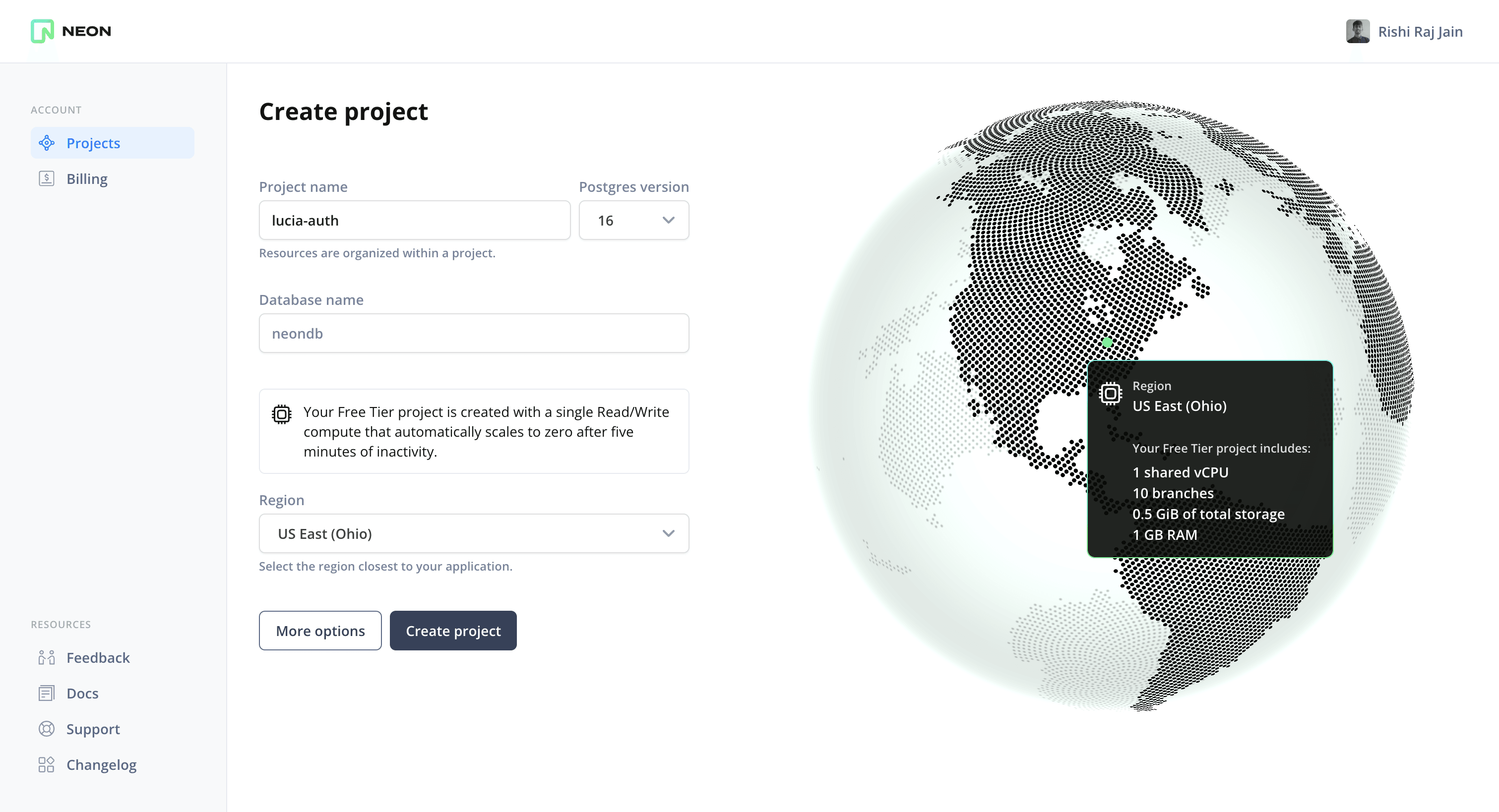
You will then be presented with a dialog that provides a connecting string of your database. Click on Pooled connection on the top right of the dialog and the connecting string automatically updates in the box below it.
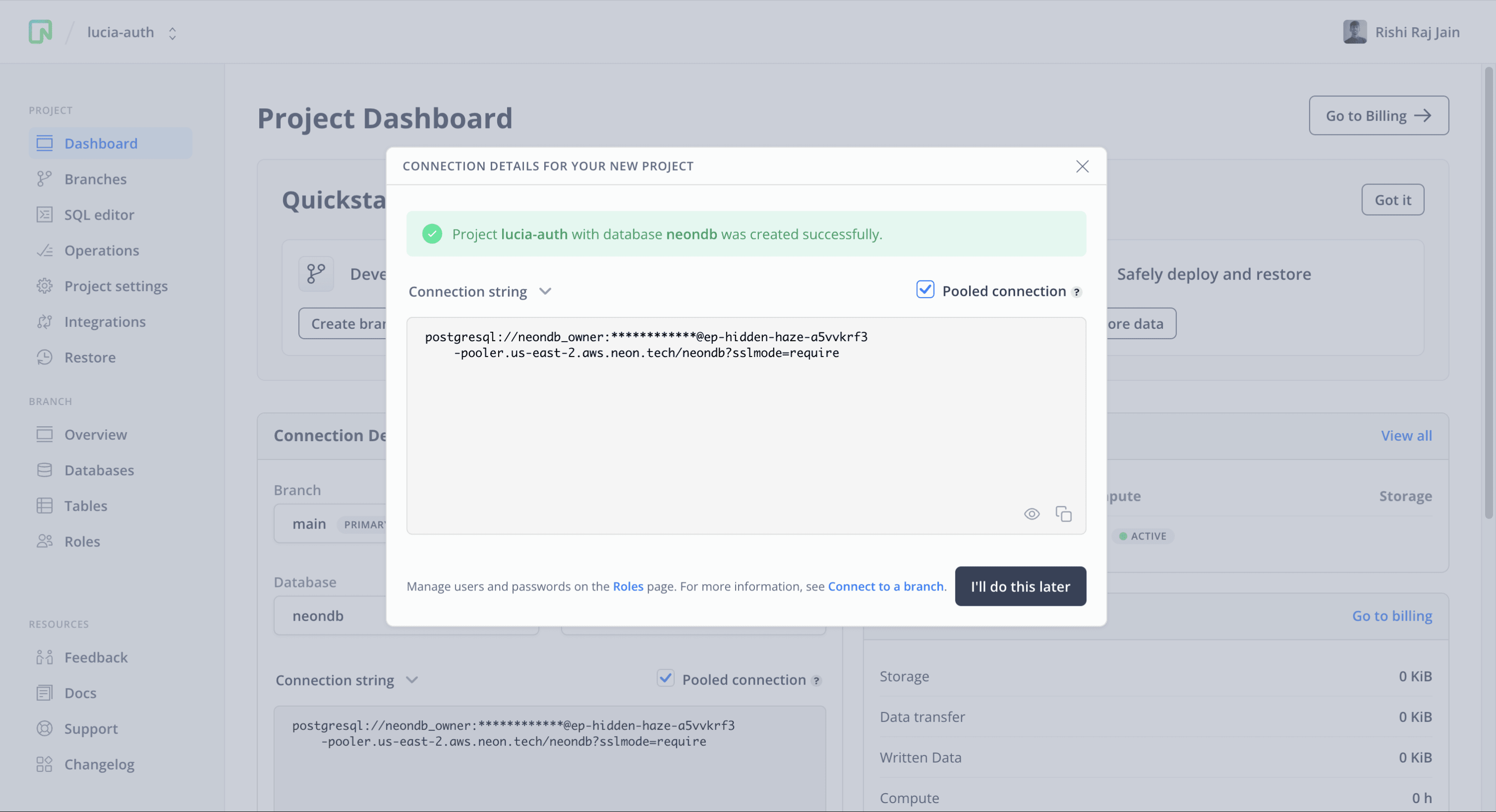
All Neon connection strings have the following format:
postgres://<user>:<password>@<endpoint_hostname>.neon.tech:<port>/<dbname>?sslmode=requireuseris the database user.passwordis the database user’s password.endpoint_hostnameis the host with neon.tech as the TLD.portis the Neon port number. The default port number is 5432.dbnameis the name of the database. “neondb” is the default database created with each Neon project.?sslmode=requirean optional query parameter that enforces the SSL mode while connecting to the Postgres instance for better security.
Save this connecting string somewhere safe to be used as the POSTGRES_URL further in the guide. Proceed further in this guide to create a Astro application.
Create a new Astro application
Let’s get started by creating a new Astro project. Open your terminal and run the following command:
npm create astro@latest authenticating-users-neon-lucianpm create astro is the recommended way to scaffold an Astro project quickly.
When prompted, choose:
Emptywhen prompted on how to start the new project.Yeswhen prompted if plan to write Typescript.Strictwhen prompted how strict Typescript should be.Yeswhen prompted to install dependencies.Yeswhen prompted to initialize a git repository.
Once that’s done, you can move into the project directory and start the app:
cd authenticating-users-neon-lucia
npm run devThe app should be running on localhost:4321.
Next, in your first terminal window, run the command below to install the necessary libraries and packages for building the application:
npm install pg
npm install -D dotenv tsx @types/pgThe above command installs the packages passed to the install command, with the -D flag specifying the libraries intended for development purposes only.
The libraries installed include:
pg: A PostgreSQL client for Node.js.
The development-specific libraries include:
@types/pg: Type definitions for pg.tsx: To execute and rebuild TypeScript efficiently.dotenv: A library for handling environment variables.
Then, make the following additions in your astro.config.mjs file to populate the environment variables and make them accessible via process.env object as well:
// File: astro.config.mjs
+ import dotenv from 'dotenv';
import { defineConfig } from 'astro/config';
+ dotenv.config();
// https://astro.build/config
export default defineConfig({});Then, make the following additions in your tsconfig.json file to make relative imports within the project easier:
{
"extends": "astro/tsconfigs/base",
+ "compilerOptions": {
+ "baseUrl": ".",
+ "paths": {
+ "@/*": ["src/*"]
+ }
+ }
}Add Tailwind CSS to the application
For styling the app, you will be using Tailwind CSS. Install and set up Tailwind at the root of our project’s directory by running:
npx astro add tailwindWhen prompted, choose:
Yeswhen prompted to install the Tailwind dependencies.Yeswhen prompted to generate a minimaltailwind.config.mjsfile.Yeswhen prompted to make changes to Astro configuration file.
With choices as above, the command finishes integrating TailwindCSS into your Astro project. It installed the following dependency:
tailwindcss: TailwindCSS as a package to scan your project files to generate corresponding styles.@astrojs/tailwind: The adapter that brings Tailwind’s utility CSS classes to every.astrofile and framework component in your project.
Enabling Server Side Rendering in Astro with Vercel
To authenticate users using server-side APIs, you’re going to enable server-side rendering in your Astro application. Execute the following command in your terminal:
npx astro add vercelWhen prompted, choose:
Yeswhen prompted to install the Vercel dependencies.Yeswhen promted to make changes to Astro configuration file.
With choices as above, the command finishes integrating Vercel adapter into your Astro project. It installed the following dependency:
@astrojs/vercel: The adapter that allows you to deploy server-side rendered Astro application to Vercel.
Setting up a Postgres Database Connection and Schema
In this section, you’ll learn how to configure a secure connection to the Postgres database, create a client to interact with it, and populate the tables in the database.
Set up the database connection
Create an .env file in the root directory of your project with the following enviroment variable to initiate the setup of a database connection:
# Neon Postgres Pooled Connection URL
POSTGRES_URL="postgres://<user>:<password>@<endpoint_hostname>.neon.tech:<port>/<dbname>?sslmode=require"The file, .env should be kept secret and not included in Git history. Ensure that .env is added to the .gitignore file in your project.
Create the database client
First, create a postgres directory in the src directory by running the following command:
mkdir src/postgresThen, to create a client that interacts with your serverless postgres, create a setup.ts file inside the src/postgres directory with the following code:
// File: src/postgres/setup.ts
// Load the environment variables
import 'dotenv/config'
// Load the postgres module
import pg from 'pg'
// Create a connection string to the postgres instance powered by Neon
const connectionString: string = `${process.env.POSTGRES_URL}`
// Create a in-memory pool so that it's cached for multiple calls
export default new pg.Pool({ connectionString })The code imports the dotenv configuration, making sure that all the environment variables in the .env file are present in the runtime. Then, the code imports the pg library, retrieves the database URL from the environment variables, and uses it to create a new pool instance, which is subsequently exported.
Create the database schema
In the postgres directory, create a file named schema.ts with the following code which will allow you to create and populate the user and sessions database tables for authentication.
// File: src/postgres/schema.ts
import pool from './setup'
async function createSchema() {
// Create the user table if it does not exist
await pool.query('CREATE TABLE IF NOT EXISTS auth_user ( id TEXT PRIMARY KEY, username TEXT UNIQUE, hashed_password TEXT );')
// Create the user_session table if it does not exist
await pool.query('CREATE TABLE IF NOT EXISTS user_session ( id TEXT PRIMARY KEY, expires_at TIMESTAMPTZ NOT NULL, user_id TEXT NOT NULL REFERENCES auth_user(id) );')
console.log('Finished setting up the database.')
// Drain the pool of all active clients, disconnect them, and shut down any internal timers in the pool.
await pool.end()
}
createSchema()The code above defines how data will be stored, organized and managed in the database. Using the pool database instance, it executes an SQL query to create a auth_user table within the database if it does not already exist. This table comprises of three columns:
- An
idcolumn for storing random identifiers for each user in the table. - A
usernamecolumn for storing unique identifiers for each user in the table. - A
hashed_passwordcolumn for storing Argon2id hashed passwords for each user in the table.
A subsequent SQL query creates a user_session table within the database if it does not already exist. This table comprises three columns:
- An
idcolumn for storing random identifiers for each session in the table. - An
expires_atcolumn for storing the timestamp with time zone for each session in the table. - An
user_idcolumn for the associatedidof each associated user for each session in the table.
After executing the two SQL queries, a message is printed to the console if there’s an error during the execution.
Finally, to execute the code in the schema file, make the following addition in the scripts of your package.json file:
{
// ...
"scripts": {
// ...
+ "db:schema": "tsx src/postgres/schema.ts"
// ...
}
// ...
}Test the database setup locally
To execute the code within schema.ts to set up the database, run the following command in your terminal window:
npm run db:schemaIf the command is executed successfully, you will see no logs in your terminal window except Finished setting up the database., marking the completion of the schema setup in your Postgres Database powered by Neon.
Setup Lucia Auth with Neon Postgres
To start authenticating users and managing their sessions, install Lucia and Oslo, for various auth utilities by executing the following command in your terminal:
npm install lucia oslo @lucia-auth/adapter-postgresql @neondatabase/serverlessThe above command installs the packages passed to the install command. The libraries installed include:
lucia: An open source auth library that abstracts away the complexity of handling sessions.oslo: A collection of auth-related utilities.@lucia-auth/adapter-postgresql: PostgreSQL adapter for Lucia.@neondatabase/serverless: Neon’s PostgreSQL driver for JavaScript and TypeScript.
Then, create a lucia directory in the src directory by running the following command:
mkdir src/luciaThen, create a file index.ts inside the lucia directory with the following code:
// File: src/lucia/index.ts
import { Lucia } from 'lucia'
import { neon } from '@neondatabase/serverless'
import { NeonHTTPAdapter } from '@lucia-auth/adapter-postgresql'
const sql = neon(import.meta.env.POSTGRES_URL)
const adapter = new NeonHTTPAdapter(sql, {
user: 'auth_user',
session: 'user_session',
})
export const lucia = new Lucia(adapter, {
sessionCookie: {
attributes: {
secure: import.meta.env.PROD,
},
},
getUserAttributes: (attributes) => {
return {
id: attributes.id,
username: attributes.username,
}
},
})
interface DatabaseUserAttributes {
id: string
username: string
}
declare module 'lucia' {
interface Register {
Lucia: typeof lucia
DatabaseUserAttributes: DatabaseUserAttributes
}
}The code above does the following:
- Imports the Lucia class, Neon HTTP serverless driver and Lucia’s PostgreSQL adapter.
- Creates a one-shot SQL query function compatible with Neon.
- Creates a Lucia adapter with the tables
auth_useranduser_session. - Creates a Lucia instance that uses cookies to maintain user sessions. The
auth_sessioncookie set by Lucia, is set to besecureif your application is running in production mode (detected by PROD Vite environment variable). UsinggetUserAttributesproperty, the Lucia instance is informed of the attributes that need to be fetched whenever a user information is requested. - Defines types related to the user information and the Lucia instance.
To fetch and validate the current user session, and to verify if the users’ credentials are valid while they’re signing up, create a file user.ts with the following code:
// File: src/lucia/user.ts
import { lucia } from '.'
import type { User } from 'lucia'
import type { AstroCookies } from 'astro'
export function getSessionID(cookies: AstroCookies): string | null {
const auth_session = cookies.get('auth_session')
if (!auth_session) return null
return lucia.readSessionCookie(`auth_session=${auth_session.value}`)
}
export async function getUser(cookies: AstroCookies): Promise<User | null> {
const { user } = await lucia.validateSession(getSessionID(cookies))
return user
}
export function validateCredentials(username, password): string | null {
// username must be between 4 ~ 31 characters, and only consists of lowercase letters, 0-9, -, and _
// keep in mind some database (e.g. mysql) are case insensitive
if (typeof username !== 'string' || username.length < 3 || username.length > 31 || !/^[a-z0-9_-]+$/.test(username)) {
return 'Invalid username'
}
if (typeof password !== 'string' || password.length < 6 || password.length > 255) {
return 'Invalid password'
}
return null
}The code above begins with the importing the lucia instance we created earlier and the types of user’s information and cookies (an Astro internal utility for cookies). Then, it exports the three function as follows:
getSessionID: it accepts all the cookies received in a request, decode theauth_sessioncookie from it, and callsreadSessionCookiefunction by lucia. It returns thesession_idassociated with the particular session.getUser: it calls thevalidateSessionfunction by lucia that returns the user and session information associated with the given cookies. The user information returned by this function contains only the attributes defined in thegetUserAttributeswe created earlier.validateCredentials: it accepts in a username and password and returns a particular message if either of them didn’t meet the validity requirements.
Define the Astro application routes
With Astro, creating a .astro or .(js|ts) file in the src/pages directory maps it to a route in your application. The name of the file created maps to the route’s URL pathname (with the exception of index.(astro|ts|js), which is the index route).
The structure below is what our pages folder will look like at the end of this section:
├── signin.astro
├── signup.astro
├── protected.astro
├── api/
├──── sign/
└────── in.ts
└────── up.ts
└────── out.tsprotected.astrowill serve responses with dynamically created HTML to incoming requests at localhost:4321/protected.signin.astrowill serve responses with statically generated HTML to incoming requests at localhost:4321/signin.signup.astrowill serve responses with statically generated HTML to incoming requests at localhost:4321/signup.api/sign/in.tswill serve responses as an API Endpoint to incoming requests at localhost:4321/api/sign/in.api/sign/up.tswill serve responses as an API Endpoint to incoming requests at localhost:4321/api/sign/up.api/sign/out.tswill serve responses as an API Endpoint to incoming requests at localhost:4321/api/sign/out.
Build the User Authentication Routes
For minimal user authentication, a user of your application should be able to sign up, sign in and sign out to your application at a given time. In this section, you’ll build the frontend pages for sign in and sign up and the API routes (in, up and out) that’ll process the user authentication logic for the same.
Build the Sign Up HTML and API Route
Create a file signup.astro in the src/pages directory with the following Astro code to serve incoming requests to /signup:
---
// File: src/pages/signup.astro
export const prerender = true
---
<html lang="en">
<head>
<meta charset="utf-8" />
<meta name="viewport" content="width=device-width" />
</head>
<body class="font-display overflow-x-hidden">
<h1>Sign Up</h1>
<form method="post" action="/api/sign/up">
<label for="username">Username</label>
<input id="username" name="username" />
<label for="password">Password</label>
<input id="password" name="password" />
<button>Continue</button>
</form>
</body>
</html>The above code does the following:
- Exports a
prerenderflag set to (boolean)trueindicating the page to be statically generated at the build time. - Serves an containing a form for users to enter their username and password in.
- Passes the form data to
/api/sign/upAPI Endpoint when user submits their information.
Let’s create the endpoint for users to sign up with. Create a file api/sign/up.ts inside the src/pages directory with the following code:
// File: src/pages/api/sign/up.ts
import pool from '@/postgres/setup'
import { generateId } from 'lucia'
import { lucia } from '@/lucia/index'
import type { APIContext } from 'astro'
import { Argon2id } from 'oslo/password'
import { validateCredentials } from '@/lucia/user'
export async function POST(context: APIContext): Promise<Response> {
const formData = await context.request.formData()
const username = formData.get('username') as string
const password = formData.get('password') as string
const message = validateCredentials(username, password)
if (message) return new Response(message, { status: 400 })
const user_id = generateId(15)
const hashed_password = await new Argon2id().hash(password)
await pool.query({
text: 'INSERT INTO auth_user (id, username, hashed_password) VALUES ($1, $2, $3)',
values: [user_id, username, hashed_password],
})
const session = await lucia.createSession(user_id, {})
const sessionCookie = lucia.createSessionCookie(session.id)
context.cookies.set(sessionCookie.name, sessionCookie.value, sessionCookie.attributes)
return context.redirect('/protected')
}The above code does the following for incoming requests to /api/sign/up:
- Imports the Postgres pool, the initialized lucia instance,
generateId,Argon2idandvalidateCredentialsfunctions. - Exports a
POSTfunction indiciating that the API route would only process the incoming POST requests. - Parses the form data in the request.
- Extracts username and password from the form data. Validates them using the
validateCredentialsfunction created earlier. - Creates a hashed password using Argon2id.
- Attempts to create the user in
auth_usertable using the pg client. Asusernameis a unique field in the database, any conflicts will result in an error response from the endpoint. - Creates a user session using
createSessionhelper by Lucia. - Sets the cookie pertaining to the user session and redirect to the
/protectedpage.
Build the Sign In HTML and API Route
Create a file signin.astro in the src/pages directory with the following Astro code to serve incoming requests to /signin:
---
// File: src/pages/signin.astro
export const prerender = true
---
<html lang="en">
<head>
<meta charset="utf-8" />
<meta name="viewport" content="width=device-width" />
</head>
<body class="font-display overflow-x-hidden">
<h1>Sign In</h1>
<form method="post" action="/api/sign/in">
<label for="username">Username</label>
<input id="username" name="username" />
<label for="password">Password</label>
<input id="password" name="password" />
<button>Continue</button>
</form>
</body>
</html>The above code does the following:
- Exports a
prerenderflag set to (boolean)trueindicating the page to be statically generated at the build time. - Serves an containing a form for users to enter their username and password in.
- Passes the form data to
/api/sign/inAPI Endpoint when user submits their information.
Let’s create the endpoint for users to sign in with. Create a file api/sign/in.ts inside the src/pages directory with the following code:
// File: src/pages/api/sign/in.ts
import pool from '@/postgres/setup'
import { lucia } from '@/lucia/index'
import type { APIContext } from 'astro'
import { Argon2id } from 'oslo/password'
import { validateCredentials } from '@/lucia/user'
export async function POST(context: APIContext): Promise<Response> {
const formData = await context.request.formData()
const username = formData.get('username') as string
const password = formData.get('password') as string
const message = validateCredentials(username, password)
if (message) return new Response(message, { status: 400 })
const existingUser = await pool.query({
text: 'SELECT id as user_id, username, hashed_password FROM auth_user WHERE username = $1',
values: [username.toLowerCase()],
})
if (!existingUser || existingUser.rowCount < 1) return new Response('Incorrect email or password', { status: 400 })
const validPassword = await new Argon2id().verify(existingUser.rows[0].hashed_password, password)
if (!validPassword) return new Response('Incorrect email or password', { status: 400 })
const session = await lucia.createSession(existingUser.rows[0].user_id, {})
const sessionCookie = lucia.createSessionCookie(session.id)
context.cookies.set(sessionCookie.name, sessionCookie.value, sessionCookie.attributes)
return context.redirect('/protected')
}The above code does the following for incoming requests to /api/sign/in:
- Imports the Postgres pool, the initialized lucia instance,
Argon2idandvalidateCredentialsfunctions. - Exports a
POSTfunction indiciating that the API route would only process the incoming POST requests. - Parses the form data in the request.
- Extracts username and password from the form data. Validates them using the
validateCredentialsfunction created earlier. - Checks for an existing user with the given username. If not found, sends a response with 400 Bad Request status.
- Otherwise, verifies the hashed password in the Neon Postgres with the password user entered. If they don’t match, sends a response with 400 Bad Request status.
- Otherwise, creates a user session using
createSessionhelper by Lucia. - Sets the cookie pertaining to the user session and redirect to the
/protectedpage.
Build the Sign Out API Route
Let’s create the endpoint for users to sign out with. Create a file api/sign/out.ts inside the src/pages directory with the following code:
// File: src/pages/api/sign/out.ts
import { lucia } from '@/lucia/index'
import type { APIContext } from 'astro'
import { getSessionID } from '@/lucia/user'
export async function GET({ cookies, redirect }: APIContext): Promise<Response> {
await lucia.invalidateSession(getSessionID(cookies))
const sessionCookie = lucia.createBlankSessionCookie()
cookies.set(sessionCookie.name, sessionCookie.value, sessionCookie.attributes)
return redirect('/protected')
}The above code does the following for incoming requests to /api/sign/out:
- Imports the initialized lucia instance, and
getSessionIDfunction. - Exports a
GETfunction indiciating that the API route would only process the incoming GET requests. - Invalidates the current user session using the
invalidateSessionhelper by Lucia. - Creates an empty user session cookie using
createBlankSessionCookiehelper by Lucia. - Sets the blank user session cookie.
- Redirects to the
/protectedpage.
Build the Protected HTML Page
Create a file protected.astro in the src/pages directory with the following Astro code to serve incoming requests to /protected:
---
// File: src/pages/protected.astro
import { getUser } from '@/lucia/user'
const user = await getUser(Astro.cookies)
if (!user) return new Response(null, { status: 403 })
---
<html lang="en">
<head>
<meta charset="utf-8" />
<meta name="viewport" content="width=device-width" />
</head>
<body class="font-display overflow-x-hidden">
<span> Protected Content for {user.id} {user.username} </span>
</body>
</html>The code above does the following to the incoming requests at /protected:
- Imports the
getUserfunction (created earlier) - Using
Astro.cookies, verifies if there is an authenticated user with the current request. If not found, returns a 403 Forbidden status. - Otherwise, it serves the protected HTML.
Great! Now you’re able to authenticate users and protected specific rouets in your application using API Endpoints in Astro and Lucia Auth.
Deploy to Vercel
The code is now ready to deploy to Vercel. Use the following steps to deploy:
- Start by creating a GitHub repository containing your app’s code.
- Then, navigate to the Vercel Dashboard and create a New Project.
- Link the new project to the GitHub repository you just created.
- In Settings, update the Environment Variables to match those in your local
.envfile. - Deploy!
Summary & Final Thoughts
In this guide, you learned how to authenticate users in your Astro application using Lucia Auth and Serverless Postgres Database powered by Neon. Further, you learned how to create protected routes that are forbidden for un-authenticated users.
For more, join us on our Discord server to share your experiences, suggestions, and challenges.
